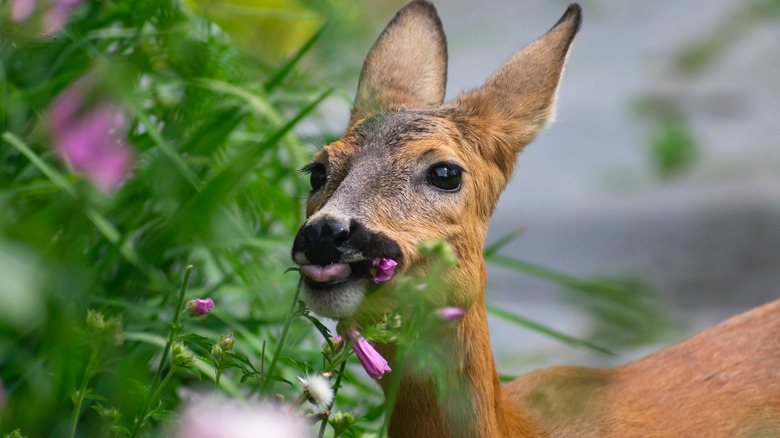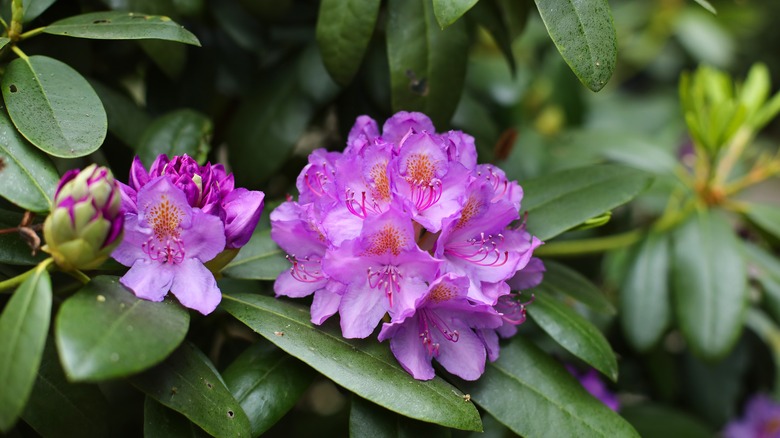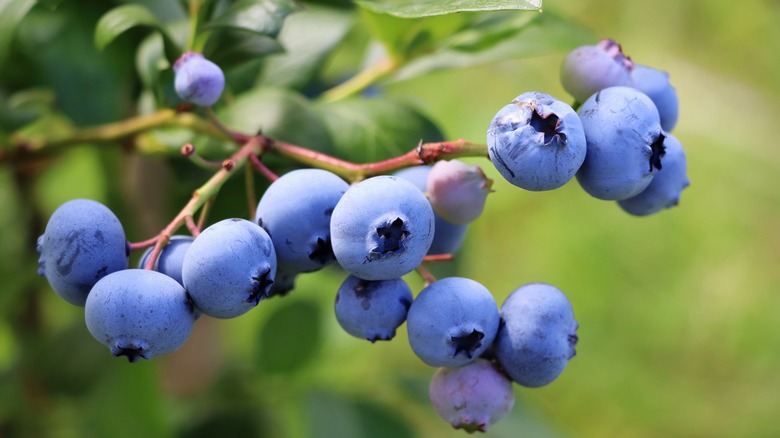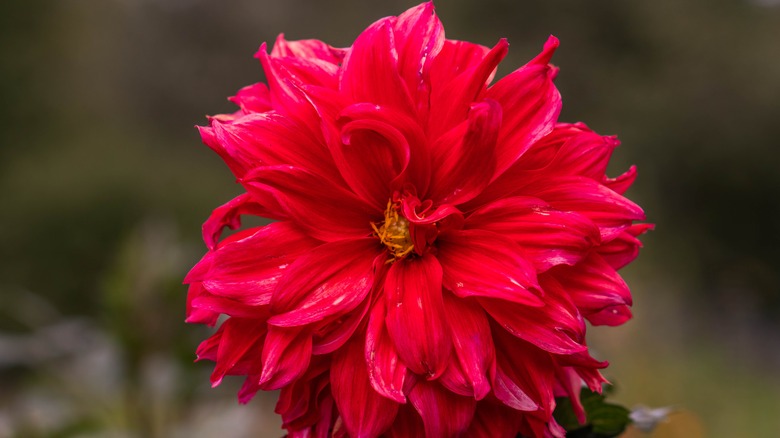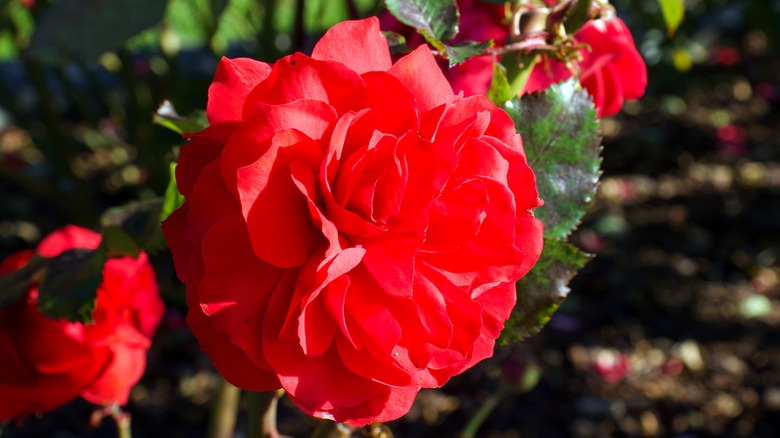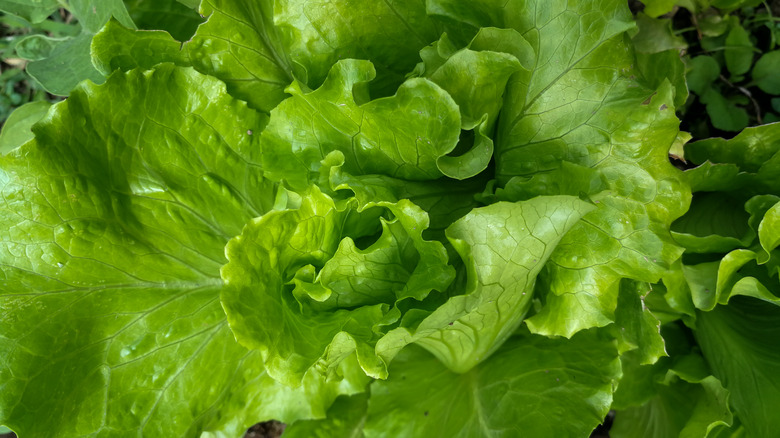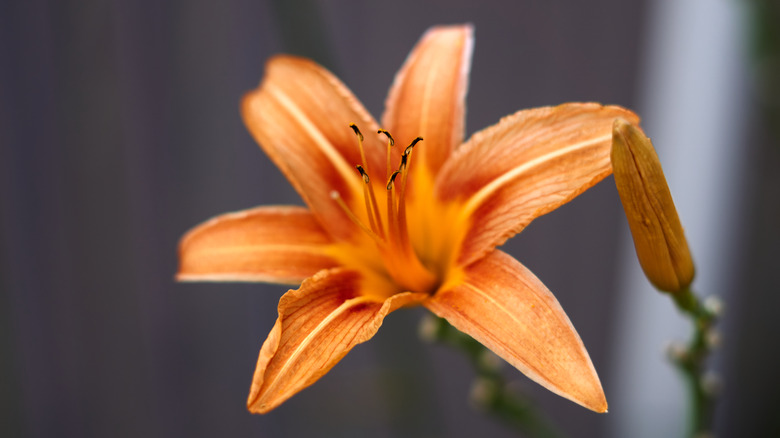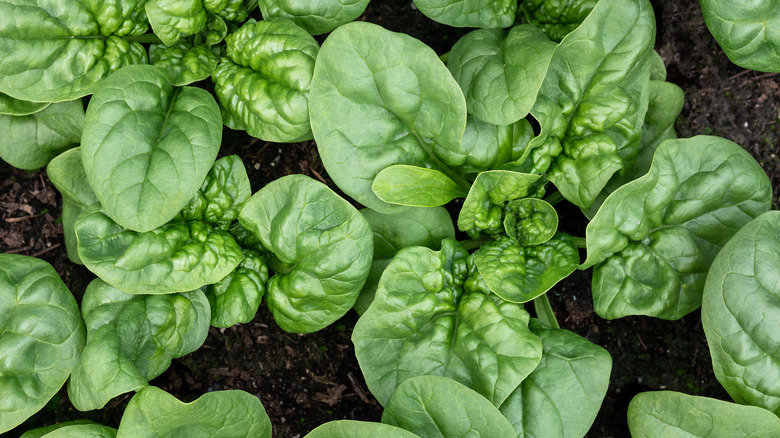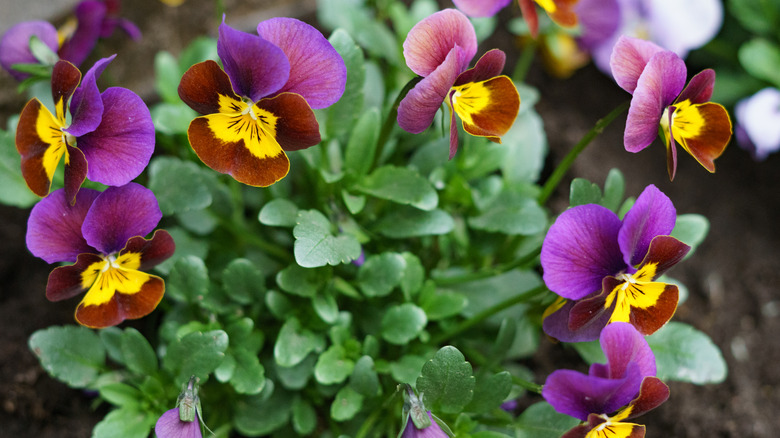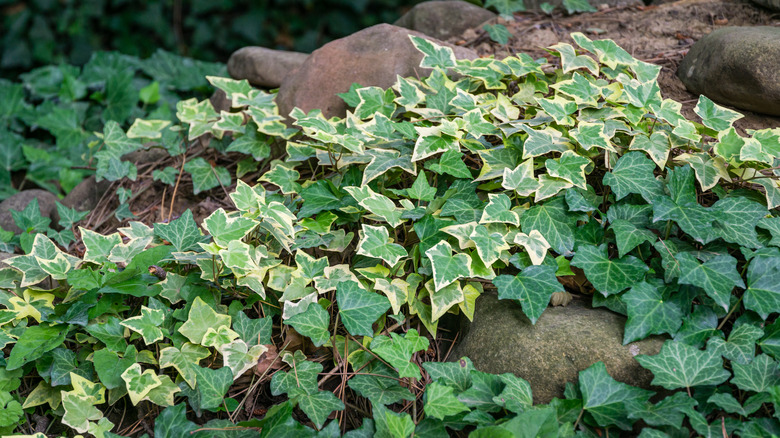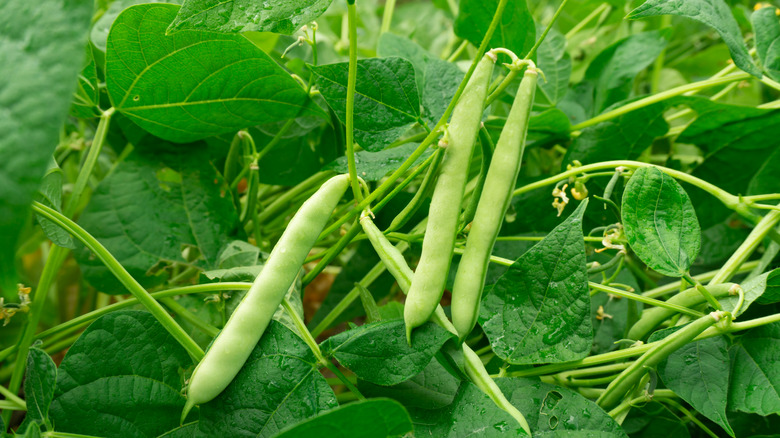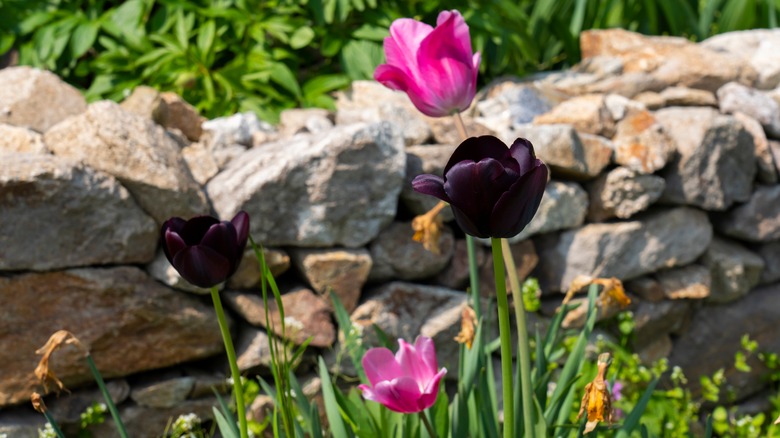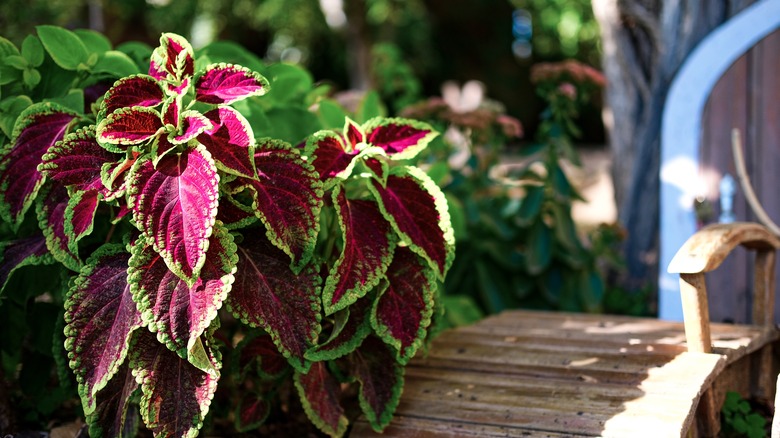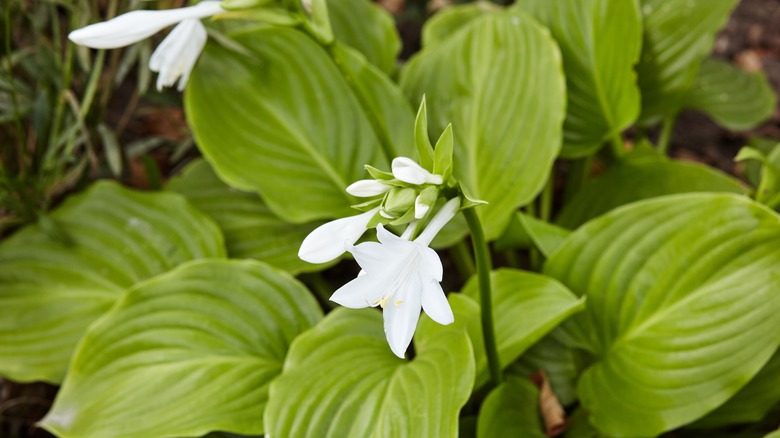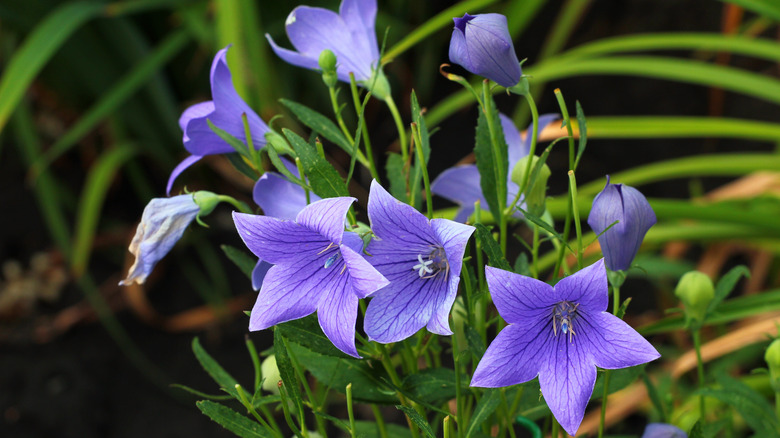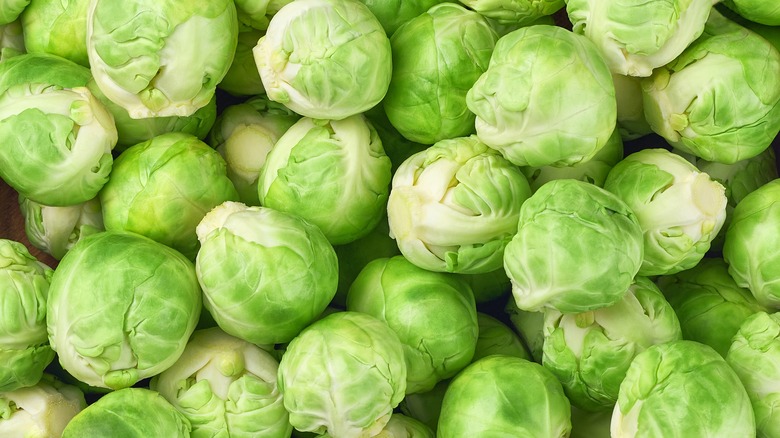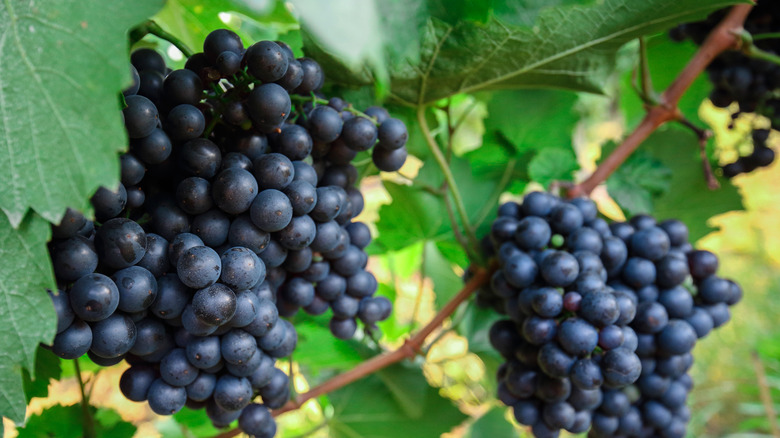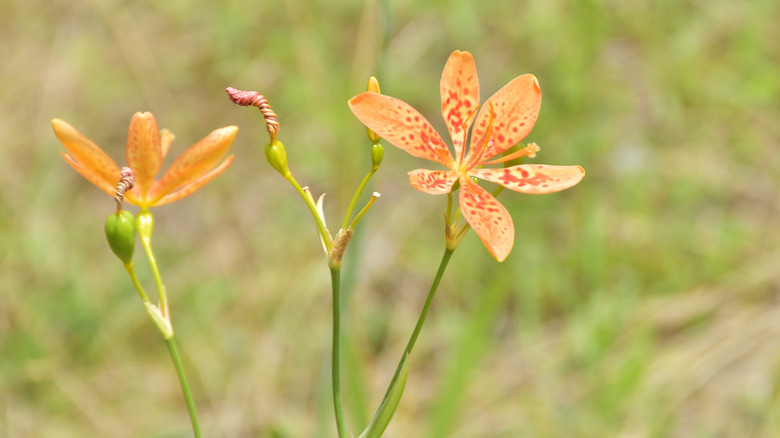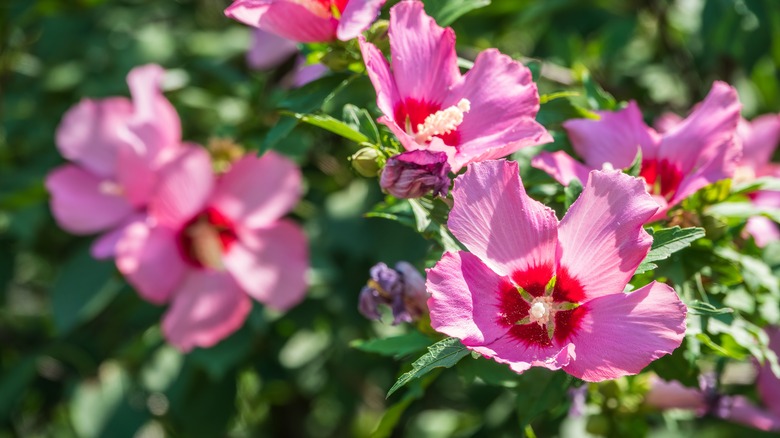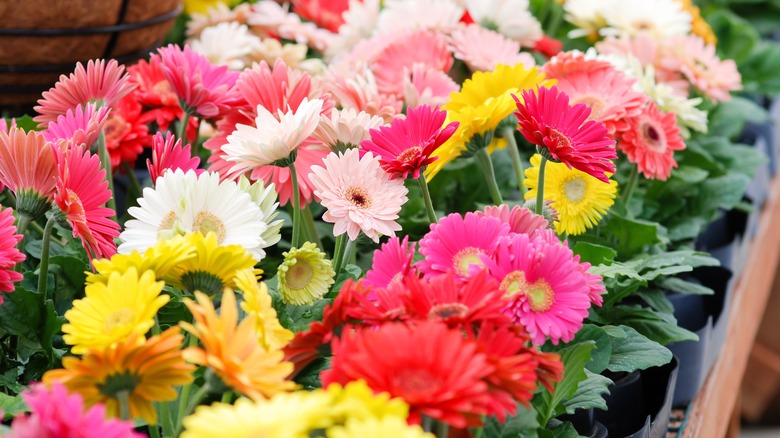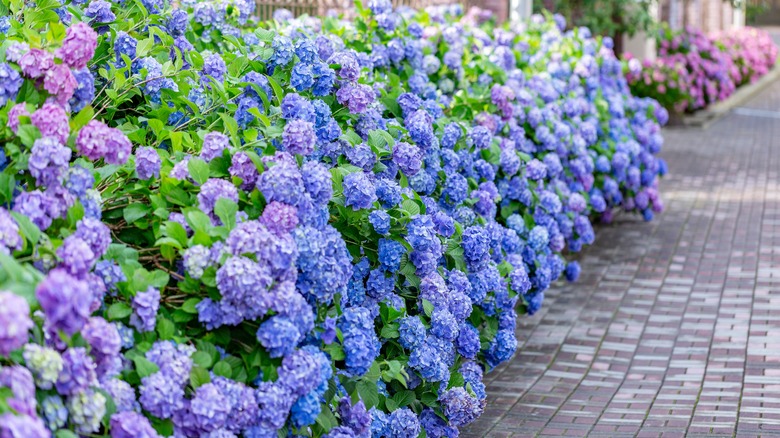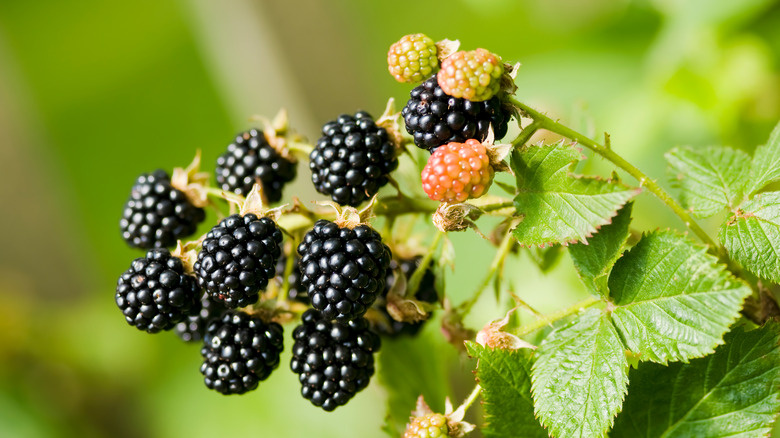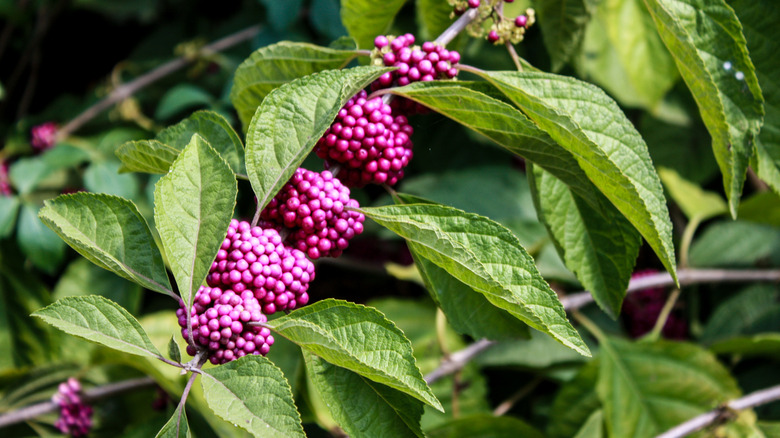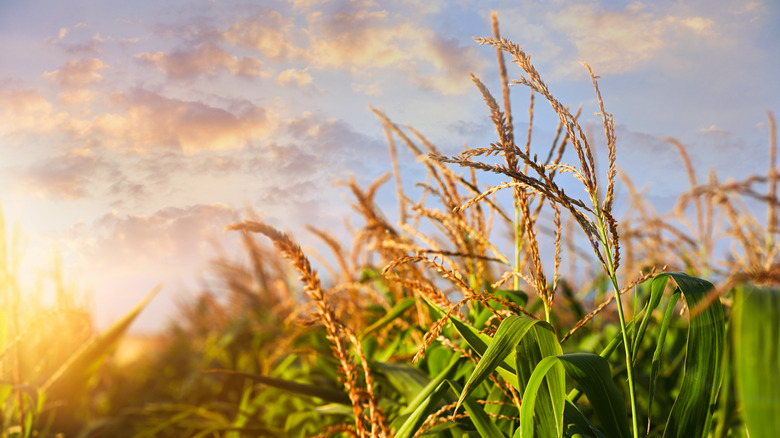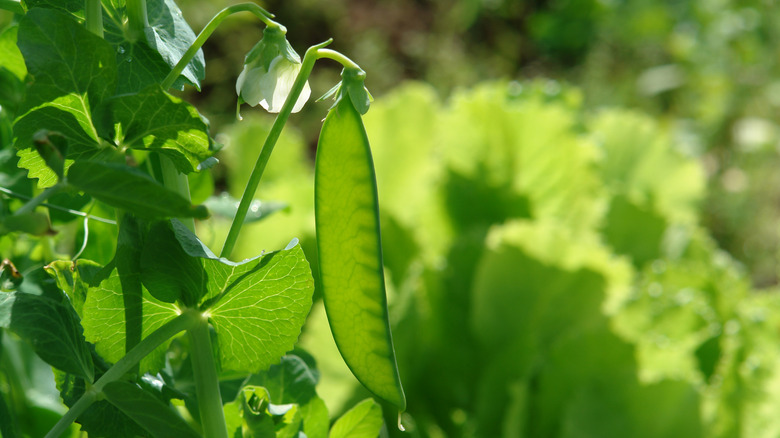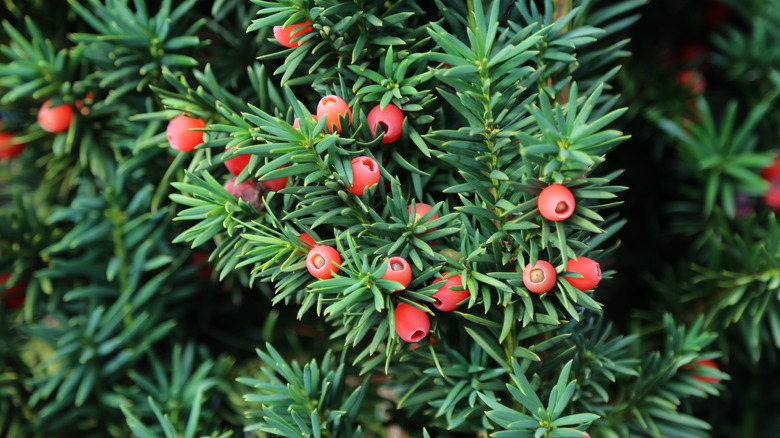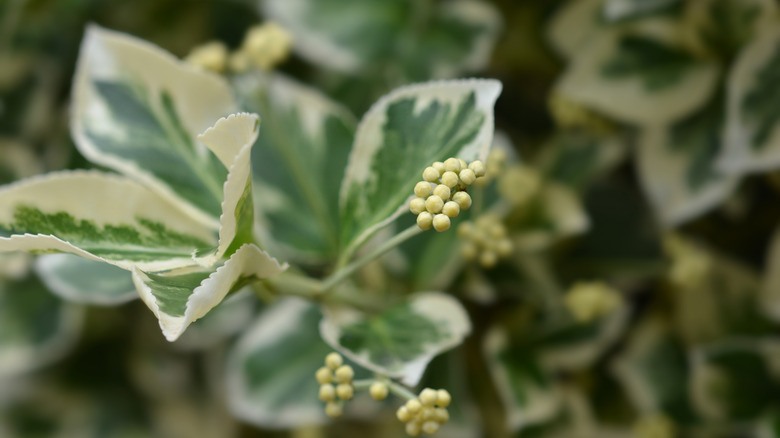Think Twice About Adding These Plants To Your Garden If You Have A Deer Problem
Depending on where you live and how your garden is set up, you may be all too familiar with deer wreaking havoc on your favorite vegetables, flowers, and foliage-filled plants. Areas with high populations of deer face an ongoing battle with these creatures, who will eat almost any plant they can stomach. Newer plant cultivars are available today to help repel the animal, but very few are actually deer-proof. If you are dealing with this problem, the best way to start fixing it is to stop planting species that are known to attract them.
Deer are particularly drawn to herbaceous broad-leaved plants, leafy parts of woody plants, seeds, grass, and mushrooms, which are normally available to them in the forest. In the summer, they will also eat berries and other fruits, but as it gets colder, they turn to acorns and evergreen leaves. If their home becomes overcrowded with herbivores, including other deer, those living near populated areas will find gardens, farms, and landscaped areas to eat a variety of crops and ornamental plants. To keep your garden safe, limit the species of plants in your yard that they enjoy dining on.
1. Azaleas
Azalea flowers (Rhododendron spp.) are known for their large blossoms and many different species that boast unique colors, bloom times, and growth habits. Unfortunately, growing healthy azaleas can be a tricky task. They are easily damaged by too much sun exposure, excess soil moisture, and a few different pests. Additionally, they are commonly eaten by deer, who love their stems and leaves as well as their fragrant flowers.
Bloom Season: Early spring to midsummer
USDA Growing Zone: 6 to 9
Growing Conditions: Partial shade
Soil Type: Well-draining, acidic, and organic
Size: Varies in height
2. Blueberry
It's no surprise that deer are enticed by the sweet fruit that grows on blueberry bushes (Vaccinium corymbosum). Along with birds, insects, and even humans, deer enjoy finding this fruit-bearing bush in the summertime to grab a quick snack. Blueberry bushes are still a great addition to your garden if you're looking for a beautiful and functional shrub, but you shouldn't expect to be the only one eating its berries.
Bloom Season: Late spring to early summer
USDA Growing Zone: 4 to 7
Growing Conditions: Full sun to partial shade
Soil Type: Well-drained
Size: 6 to 12 feet tall
3. Dahlia
Dahlias (Dahlia spp.), like azaleas, are large flowers that can be difficult to care for. Despite this, many gardeners take on the challenge of growing dahlias in their yards because of the many available cultivars and hybrids. If you also want to try your hand at raising dahlias, be sure to find them a sunny location and provide plenty of water.
Bloom Season: Summer
USDA Growing Zone: 8 to 11
Growing Conditions: Full sun
Soil Type: Loose, evenly moist, and well-draining
Size: 1 to 6 feet tall
4. Floribunda rose
Yet another large bloomer, floribunda roses (Rosa Europeana) appear on this deciduous shrub from spring to fall. The flowers and the foliage on the rose bush are attractive to deer as well as bees, butterflies, hummingbirds, and other pollinators. Although these plants are stunning, if you have a deer problem, you won't want to plant them in your garden.
Bloom Season: Spring to fall
USDA Growing Zone: 5 to 11
Growing Conditions: Full sun
Soil Type: Well-draining
Size: 2 to 3 feet tall and wide
5. Lettuce
It can be challenging to raise a vegetable garden if you have a deer problem. Lettuce (Lactuca sativa) is one of their most-loved foods, which they can eat to the ground if they are hungry enough. There are many ways you can repel deer from your garden to prevent their damage, but keeping lettuce growing while deer continue to frequent your garden will be a challenge.
USDA Growing Zone: 2 to 11
Growing Conditions: Full sun to partial shade
Soil Type: Fertile and well-draining
Size: 6 to 12 inches tall and wide
6. Daylily
Daylilies (Hemerocallis spp.) are very easy flowers to grow. During the growing season, they show off gorgeous lily-like flowers and strappy green leaves that make the flower colors stand out. There are many daylily species and cultivars, so the blooms come in a range of warm colors, including purple, orange, yellow, and red.
Bloom Season: Summer to fall
USDA Growing Zone: 6 to 7
Growing Conditions: Full sun
Soil Type: Well-draining
Size: 1 to 3 feet tall and 1 to 2 feet wide
7. Spinach
Spinach plants (Spinacia oleracea) are packed with awesome vitamins and nutrients such as iron and vitamin C. The leaves are usually consumed by humans looking for a healthy meal or snack to recharge their bodies, but we aren't the only ones to reap the spinach plant's benefits. Deer too will often seek out spinach leaves to refill their stomachs.
Bloom Season: Summer
USDA Growing Zone: 1 to 11
Growing Conditions: Full sun to partial shade
Soil Type: Rich, organic, and well-draining
Size: 6 inches to 1 foot tall and wide
8. Pansy
Pansies (Viola tricolor var. hortensis) are annual flowers that bloom throughout the growing season. Though they can be planted almost anywhere in the garden, we recommend keeping them in hanging containers that protect them from grazing deer. Unfortunately, deer aren't the only problem for pansies. They are also frequently affected by pests such as slugs, aphids, snails, and violet gall midges.
Bloom Season: Spring to fall
USDA Growing Zone: 2 to 9
Growing Conditions: Full sun to partial shade
Soil Type: Evenly moist and well-draining
Size: 4 to 20 inches tall
9. English ivy
English ivy (Hedera helix) is an invasive plant that grows quickly and aggressively. Many people find this out the hard way when a patch of their yard becomes overrun with it. Though some of us have grown to dislike the ivy plant, deer find it to be a yummy meal. It is often damaged by deer, but can make for a gorgeous indoor plant.
Bloom Season: Summer and fall
USDA Growing Zone: 4 to 13
Growing Conditions: Full sun to deep shade
Soil Type: Rich and well-draining
Size: Up to 80 feet long
10. Beans
Beans (Phaseolus vulgaris) are an excellent addition to most gardens as they pull nitrogen from the air and supply it to nearby companion plants such as broccoli and carrots. However, they are also a favorite snack of a few wildlife creatures. For example, deer tend to feed heavily on the plants when given access, making harvest season difficult.
Bloom Season: Seasonal bloomer
USDA Growing Zone: 2 to 11
Growing Conditions: Full sun
Soil Type: Rich, fertile, moist, and well-draining
Size: 2 to 15 feet tall and 2 to 3 feet wide
11. Tulip
Tulips (Tulipa spp.) are a sign of spring. As we break out of the frigid winter months, tulips rear their gorgeous heads to let us know that warmer days are on their way. Their beautiful flowers grow from bulbs that are normally quite reliable and create a rush of color for a couple of weeks after sprouting — unless you have a high deer population where you live.
Bloom Season: Spring
USDA Growing Zone: 3 to 8
Growing Conditions: Full sun
Soil Type: Fertile, organically rich, and well-draining
Size: 4 to 52 inches tall and 6 to 9 inches wide
12. Coleus
Coleus (Coleus spp.) plants are characterized by large and colorful leaves that can be green, purple, pink, white, yellow, and many shades in between. Grown outdoors, coleus plants can be simple to care for as long as they stay warm enough. Unfortunately, these warm-weather plants cannot withstand temperatures below 60 degrees Fahrenheit. Like many other foliage-filled plants, hungry deer occasionally severely damage coleus.
Bloom Season: Spring and fall
USDA Growing Zone: 10 to 11
Growing Conditions: Full shade to full sun, depending on the cultivar
Soil Type: Well-drained
Size: 6 to 36 inches tall
13. Hostas
Hostas (Hosta plantaginea) are among deers' favorite plants to eat. The large and smooth leaves make for a delightful meal. If there is a sizable deer population near your garden, it's recommended that you don't grow unprotected hostas in your yard. Deer will seek them out and munch on their foliage.
Bloom Season: Mid-summer
USDA Growing Zone: 3 to 9
Growing Conditions: Partial shade
Soil Type: Moist, organic, and well-draining
Size: 2 inches to 3 feet tall and 4 inches to 5 feet wide
14. Balloon flower
Balloon flowers (Platycodon grandiflorus) are named for their blooms, which look like balloons just before they burst open, and show off their pretty star-shaped flowers that are typically 2 or 3 inches in diameter. The flowers, as well as the stems and leaves, are palatable to deer who are known to severely damage the plants when they come across them.
Bloom Season: Summer
USDA Growing Zone: 3 to 8
Growing Conditions: Full sun to partial shade
Soil Type: Rich, loamy, and well-draining
Size: 12 to 30 inches tall and 12 to 18 inches wide
15. Brussels sprouts
Brussels sprouts (Brassica oleracea, Gemmifera group) grow best in cool-season vegetable gardens, where they can be harvested for roasting with some meat, cheese, and other vegetables. Sadly, if you have a deer problem, this brassica species, along with its relatives cabbage, broccoli, and cauliflower, won't be a good fit for your vegetable garden.
Bloom season: Rarely flowers before harvest
USDA Growing Zone: 2 to 11
Growing Conditions: Full sun
Soil Type: Rich, fertile, moist, and well-draining
Size: 2 to 3 feet tall and 1 to 2 feet long
16. Grapes
Believe it or not, deer love grapes (Vitis vinifera). They are particularly attracted to the vines when they are still trying to establish themselves and bear their delicious fruit. As the vines become woodier with age, deer will likely become less attracted to the plants. Yet, without protection from hungry wildlife, grape vines are always at risk of being damaged by heavy feeders.
Bloom Season: Spring and summer
USDA Growing Zone: 6 to 10
Growing Conditions: Full sun to partial shade
Soil Type: Well-draining
Size: Over 100 feet long
17. Candy lily
Candy lilies (Pardancanda x norrisii) are the product of crossing a blackberry lily and a vesper iris. From this cross, we get a unique flower that blooms in several distinct colors, including pink, yellow, purple, and red. Each of these blossoms has six petals and many strap-like leaves that deer will eat if given the chance.
Bloom Season: Summer
USDA Growing Zone: 5 to 9
Growing Conditions: Full sun to partial shade
Soil Type: Humusy or sandy and well-draining
Size: 12 to 18 inches tall and 9 to 12 inches wide
18. Hardy hibiscus
Hardy hibiscus (Hibiscus moscheutos) is occasionally mangled by hungry deer looking for something to eat. The gorgeous perennial produces flowers that are often even more attractive to us humans than they are to deer. Young plants are usually targeted by our hoofed friends who like the green stems and tasty toothed foliage.
Bloom Season: Summer
USDA Growing Zone: 5 to 8
Growing Conditions: Full sun
Soil Type: Rich and wet
Size: 4 to 7 feet tall and 3 to 4 feet wide
19. Gerbera daisy
Gerbera daisies (Gerbera jamesonii) are flowers that prefer to grow in warm climates with rich and fertile soil. In the garden, gerbera daisies have almost no issues thriving. Most often, they are affected by pests such as thrips, aphids, and spider mites. However, you should be careful if deer frequent your garden, as they are known to eat them on occasion.
Bloom Season: Spring and Fall
USDA Growing Zone: 8 to 10
Growing Conditions: Full sun to partial shade
Soil Type: Rich and well-draining
Size: 12 to 18 inches tall and wide
20. Hydrangea
Hydrangea bushes (Hydrangea macrophylla) make for a beautiful foundation planting to grow in your front yard. Yet, unless your yard is fenced, this is also the worst place to plant them as it gives deer easy access to their large flowers and tender leaves. These bushes, with the exception of attracting deer, are relatively pest and disease-free as long as they are cared for properly.
Bloom Season: Summer
USDA Growing Zone: 6 to 11
Growing Conditions: Dappled sunlight to full shade
Soil Type: Evenly moist and well-draining
Size: 3 to 6 feet tall and wide
21. Blackberry bush
Blackberry bushes (Rubus fruticosus) are an essential food source for deer. The berries and green material are sought out by the hoofed mammals as well as several species of birds and rodents. The blackberries ripen in the summer, but deer will continue to find them in the fall, even if they are dry. If there are no berries, they will still eat the plant's leaves and young stems.
Bloom Season: Spring
USDA Growing Zone: 5 to 9
Growing Conditions: Full sun
Soil Type: Well-drained and organically rich
Size: 5 to 9 feet tall and wide
22. Beautyberry
The beautyberry bush (Callicarpa americana) is called deer resistant by some, but other gardeners and landscapers report having problems with deer munching on the stems, leaves, and berries. Because deer are unlikely to eat the entire plant down to the ground, it can be used to border wildlife gardens where pollinators, birds, and animals can benefit from it.
Bloom Season: Summer
USDA Growing Zone: 7 to 11
Growing Conditions: Full sun, partial shade, or full shade
Soil Type: Slightly acidic clay, loam, or sand
Size: 3 to 6 feet tall and wide
23. Corn
Corn plants (Zea mays) enjoy warm weather, direct sunlight, and plenty of water. They are a great summer and fall crop to grow at home for barbeques with buttered corn-on-the-cob or corn salsa. Yet, if you're dealing with a deer problem, you might want to stick to buying your corn at the grocery store. Whitetail deer pose a threat to corn growing in your garden, as they are known to damage field corn.
Bloom Season: Summer
USDA Growing Zone: 2 to 11
Growing Conditions: Full sun
Soil Type: Well-draining
Size: 5 to 8 feet tall
24. Peas
Peas (Pisum sativum) are grown as annuals in gardens all over the United States, as well as in other countries that can support their growth. To grow properly, peas need moist and well-draining soil in a very sunny location. Though they are all of the same species, pea plants come in several varieties, many of which deer like to browse.
Bloom Season: Spring and fall
USDA Growing Zone: 2 to 11
Growing Conditions: Full sun to partial shade
Soil Type: Sandy and well-draining
Size: 12 to 18 inches tall and 6 to 12 inches wide
25. Yew
Yew shrubs (Taxus spp.), despite being very toxic to humans, horses, cats, and dogs, are a favored treat for deer. They show off green, needle-like foliage and sometimes bear red berries in the fall. These berries are often eaten by birds, who usually won't damage the plant itself, unlike deer.
Bloom Season: Spring
USDA Growing Zone: 4 to 8
Growing Conditions: Full sun to partial shade
Soil Type: Well-draining
Size: Varies by species
26. Wintercreeper
Wintercreeper plants (Euonymus fortunei) are among the most well-known landscape plants frequently damaged by deer. The sprawling shrub is a creeping plant, as the name suggests, and it can grow widely and very tall if it isn't watched carefully. Because of this, wintercreeper is considered an invasive plant in some areas.
Bloom Season: Summer
USDA Growing Zone: 5 to 9
Growing Conditions: Full sun, partial shade, or dappled sunlight
Soil Type: Well-draining loam, clay-loam, sand, or gravel
Size: 14 to 32 feet tall and 2 to 10 feet wide
